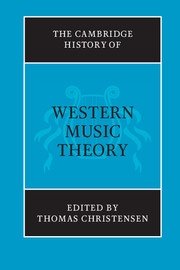Book contents
- Frontmatter
- Introduction
- PART I DISCIPLINING MUSIC THEORY
- PART II SPECULATIVE TRADITIONS
- 4 Greek music theory
- 5 The transmission of ancient music theory into the Middle Ages
- 6 Medieval canonics
- 7 Tuning and temperament
- 8 The role of harmonics in the scientific revolution
- 9 From acoustics to Tonpsychologie
- 10 Music theory and mathematics
- PART III REGULATIVE TRADITIONS
- PART IV DESCRIPTIVE TRADITIONS
- Index of authors
- Index of subjects
- References
10 - Music theory and mathematics
from PART II - SPECULATIVE TRADITIONS
Published online by Cambridge University Press: 28 March 2008
- Frontmatter
- Introduction
- PART I DISCIPLINING MUSIC THEORY
- PART II SPECULATIVE TRADITIONS
- 4 Greek music theory
- 5 The transmission of ancient music theory into the Middle Ages
- 6 Medieval canonics
- 7 Tuning and temperament
- 8 The role of harmonics in the scientific revolution
- 9 From acoustics to Tonpsychologie
- 10 Music theory and mathematics
- PART III REGULATIVE TRADITIONS
- PART IV DESCRIPTIVE TRADITIONS
- Index of authors
- Index of subjects
- References
Summary
In Chapter 6 of The Manual of Harmonics (early second century CE), Nicomachus of Gerasa narrates the legendary story of Pythagoras passing by the blacksmith’s shop, during which in an epiphany of sonorous revelation, he discovered the correlation of sounding intervals and their numerical ratios. According to Nicomachus, Pythagoras perceived from the striking of the hammers on the anvils the consonant intervals of the octave, fifth, and fourth, and the dissonant interval of the whole tone separating the fifth and fourth. Experimenting in the smithy with various factors that might have influenced the interval differences he heard (force of the hammer blows, shape of the hammer, material being cast), he concluded that it was the relative weight of the hammers that engendered the differences in the sounding intervals, and he attempted to verify his conclusion by comparing the sounds of plucked strings of equal tension and lengths, proportionally weighted according to the ratios of the intervals.
Physical and logical incongruities or misrepresentations in Nicomachus’s narrative aside, the parable became a fixture of neo-Pythagorean discourse because of its metaphoric resonance: it encapsulated the essence of Pythagorean understanding of number as material or corporeal, and it venerated Pythagoras as the discoverer of the mathematical ratios underlying the science of harmonics. The parable also established a frame of reference in music-theoretical thought in the association between music and number, or more accurately, music theory and mathematical models, since it is not through number alone but through the more fundamental notions of universality and truth embedded in Pythagorean and Platonic mathematics and philosophy that one can best begin to apprehend the broad range of interrelationships between music theory and mathematics.
- Type
- Chapter
- Information
- The Cambridge History of Western Music Theory , pp. 272 - 304Publisher: Cambridge University PressPrint publication year: 2002
References
- 34
- Cited by



